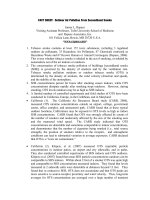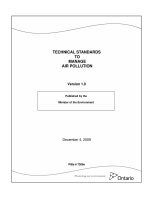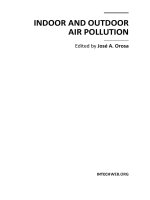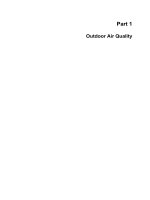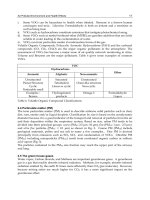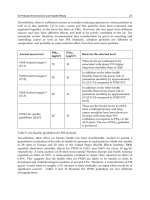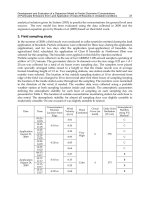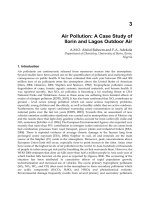Indoor and Outdoor Air Pollution Part 1 pptx
Bạn đang xem bản rút gọn của tài liệu. Xem và tải ngay bản đầy đủ của tài liệu tại đây (357.21 KB, 10 trang )
INDOOR AND OUTDOOR
AIR POLLUTION
Edited by José A. Orosa
Indoor and Outdoor Air Pollution
Edited by José A. Orosa
Published by InTech
Janeza Trdine 9, 51000 Rijeka, Croatia
Copyright © 2011 InTech
All chapters are Open Access articles distributed under the Creative Commons
Non Commercial Share Alike Attribution 3.0 license, which permits to copy,
distribute, transmit, and adapt the work in any medium, so long as the original
work is properly cited. After this work has been published by InTech, authors
have the right to republish it, in whole or part, in any publication of which they
are the author, and to make other personal use of the work. Any republication,
referencing or personal use of the work must explicitly identify the original source.
Statements and opinions expressed in the chapters are these of the individual contributors
and not necessarily those of the editors or publisher. No responsibility is accepted
for the accuracy of information contained in the published articles. The publisher
assumes no responsibility for any damage or injury to persons or property arising out
of the use of any materials, instructions, methods or ideas contained in the book.
Publishing Process Manager Natalia Reinic
Technical Editor Teodora Smiljanic
Cover Designer Jan Hyrat
Image Copyright vpix, 2010. Used under license from Shutterstock.com
First published June, 2011
Printed in India
A free online edition of this book is available at www.intechopen.com
Additional hard copies can be obtained from
Indoor and Outdoor Air Pollution, Edited by José A. Orosa
p. cm.
ISBN 978-953-307-310-1
free online editions of InTech
Books and Journals can be found at
www.intechopen.com
Contents
Preface VII
Part 1 Outdoor Air Quality 1
Chapter 1 Air Polluted Environment and Health Effects 3
Michael Theophanides, Jane Anastassopoulou
and Theophile Theophanides
Chapter 2 Development and Evaluation of a Dispersion
Model to Predict Downwind Concentrations of
Particulate Emissions from Land Application of
Class B Biosolids in Unstable Conditions 29
Abhishek Bhat, Ashok Kumar and Kevin Czajkowski
Chapter 3 Air Pollution: A Case Study of
Ilorin and Lagos Outdoor Air 41
A.M.O. Abdul Raheem and F.A. Adekola
Chapter 4 Spectroscopy Analysis of Corrosion in the
Electronic Industry Influenced by Santa Ana
Winds in Marine Environments of Mexico 61
Gustavo Lopez, Benjamin Valdez and Michael Schorr
Part 2 Indoor Air Quality 77
Chapter 5 Correlation of Professional Performance to
AcceptableIAQ in Critical Care Medical Facilities 79
H.W. Holder, K.V. Easterwood, Jr., D.E. Johnson,
J.W. Sealy, M.D.Larranaga and D.C. Straus
Chapter 6 Air Quality Degradation: Can Economics
Help in Measuring its Welfare Effects?
A Review of Economic Valuation Studies 105
Eva Kougea and Phoebe Koundouri
Preface
The atmosphere is the layer of air surrounding the earth and its structure below 50 km
is most important in determining pollution levels. In this sense, greenhouse effect and
climate change are evoking a special interest recently since they are considered to be
human hazards. Greenhouse effect is produced by infrared radiations, imprisoned
between the earth and the thin layer of greenhouse gases, which get reflected and heat
up the earth’s surface. These gases allow the sun’s radiations of shorter wavelengths to
pass through when they are reflected from the surface of the earth, but do not allow
the radiations of longer wavelengths, which are the hot infrared radiations, reflected
from the earth to go out because of which there is an increase in temperature on the
surface of the earth. The temperature of the earth increases by almost half a degree per
century and this phenomenon tends to rapidly increase causing climate change and
influencing human health.
Greenhouse effect and climate change are not the only human hazards to be
considered. Indoor and outdoor air quality must also be considered in this context. Air
quality is a measure of the degree of ambient atmospheric pollution. Deterioration and
damage to both public health and environment due to poor air quality have been
recognized at a legislative and international level. Air pollution is often quantified for
purposes of comparison or threshold attainment using the air quality index (AQI).
This and other indexes will be shown in-depth in Chapter 1.
On the other hand, the ambient concentration of criteria pollutants found within the
atmosphere of a domain can be predicted or simulated by numerical simulation. The
principal application of air pollution modeling is to investigate the air quality scenario
so that the associated environmental impact on a selected area can be predicted and
quantified. The Geographical Information System (GIS) was applied to this type of
analysis in order to organize the data results. In accordance with this point of view
and previous concepts, different case studies about outdoor and indoor air quality
have been analyzed in this book.
The first case study, Chapter 2, shows how to model the particulate matter released
during and after the application of biosolids based on the data collected during the
field study. The objective of this case study was to develop and evaluate a dispersion
VIII Preface
model for particulate matter associated with biosolid application on a farm field. The
efforts include a derivation of solution to a convective–diffusion equation
incorporating wind shear.
Air pollutants are continuously released from numerous sources into the atmosphere.
Several studies have been carried out on the quantification of pollutants and their
consequences on public health. Identification of the source characteristics of air
pollution is an important step in the development of regional air quality control
strategies. In this sense, the aim of the second case study, Chapter 3, was to analyze the
environmental data gathered on the daily monitoring of ambient ozone, oxides of
nitrogen, and sulfur (IV) oxide at five monitoring sites. Furthermore, in recent years,
certain statistical techniques that incorporate the influence of meteorological variables
have been applied to assess the trend in ozone levels in ambient air. One common
approach is the use of a parametric regression model to link different parameters to
meteorological variables. In this approach, another of the case studies shows, in
Chapter 4, how the cooper materials can be corroded by Santa Ana Winds.
After the conduct of case studies on outdoor air, it is time to comment on indoor air. In
this book, different topics on indoor air quality are discussed. One case study shows,
in Chapter 5, a correlation of professional performance to acceptable IAQ in critical
care medical facilities. This case study is especially interesting with regard to, at
present, the quality of the indoor environment for the health and safety of occupants
as well as the protection of assets, which is becoming a prime concern with end users.
Other case studies conducted a review of the economic valuation studies as a
theoretical framework of welfare economics and provided a brief description of the
fundamental issues arising in such environmental problems, as we can see in Chapter
6. It is an interesting point of view and the currently available methods for estimating
monetary values of changes in well-being due to air pollution are shown.
To summarize, this book tries to reveal different points of view of the wide concept of
air quality. In this context, there will be an initial introductory chapter on the main
concepts of air quality, following which there will be real case studies on outdoor and
indoor air quality with an aim to provide a guideline for future standards and research
works.
José A. Orosa
Departamento de Energía y P.M.
Universidade da Coruña
Coruña,
Spain
